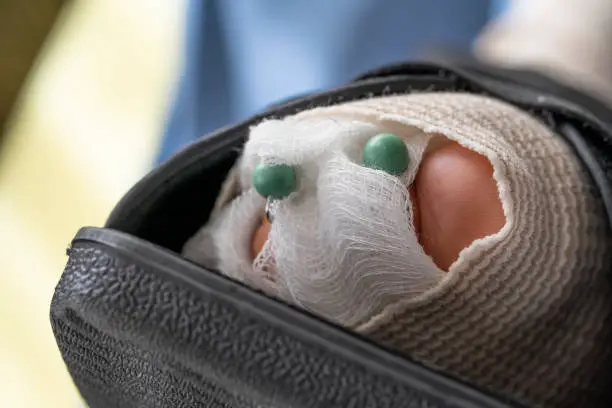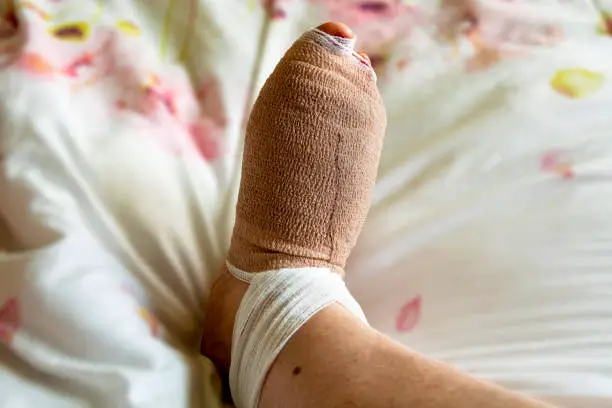How to Fix Hammer Toes With Tape?
Another option, if your toe joint is flexible, is to tape your hammer toe. Wrap the tape around the big toe (or the toe next to the hammer toe), then the hammer toe, and then the toe. The hammer toe is then gently forced into its usual position.
Bring one foot and rest it on your opposite thigh while sitting comfortably. Then, softly squeeze your fingers while squeezing your toes together. Slide your fingers in between your toes. Twelve times through the workout.
There are several ways to fix hammer toes. These include surgery or orthotics. Home remedies may also help relieve pain. For instance, massaging the affected area may be effective. Toe socks are another option. If none of these methods seem adequate, consider consulting a doctor or podiatrist.
Kinesiology Taping
If you have hammer toes, Kinesiology Taping can help fix the problem. You can purchase this tape from your local pharmacy and cut it to fit around the toe. Make sure to wrap the tape tightly enough to bend the toe into the correct shape, but not too tight that it hurts. You can also wrap the tape under the third toe on the opposite side, which will help straighten out both sides of the toe.
The initial deformity of a hammer toe is caused by a bend in the proximal interphalangeal joint and compensatory dorsiflexion of the distal interphalangeal joint. The initial deformity is flexible and reversible, but later on, it may become rigid due to contracture of the periarticular structures.
Using Kinesiology Taping to fix a patient’s hammer toes can help with pain and discomfort. The tape is usually a 2.5 cm wide sheet of 3NS TEX tape placed on the bottom of the foot in a Y-shape. The physiotherapist will change the tape every three to four days. While the patient is wearing the tape, they should do dorsiflexion exercises on the PIP joint to improve the flexibility of their toes.
Kinesiology Taping to fix a hammer toe is a relatively straightforward procedure. First, you need a piece of tape and a helper. Next, you should wrap the tape under the toe nearest to the afflicted toe. Next, pull the tape tightly, holding the toe in place. When you are done, have your helper hold the tape in place so that you can cut it.
Kinesiology Taping is an effective conservative treatment for hammer toe. It helps correct the deformity by changing the position of the tiny toes. As a result, patients can expect less pain when walking, swimming, or doing other activities. It is also an alternative to corrective surgery.
The most effective treatment method for hammer toes is a combination of physical therapy and kinesiology taping. If these do not work, you may want to try other treatments. Some people find home remedies like massaging the area can help relieve pain.
Pumice Stone
Hammer toes can be painful and uncomfortable to wear, but there are several things you can do to ease your discomfort. Buying comfortable shoes with soft upper materials that give your toes more room in the toe box will help you feel less pressure and pain. Using a pumice stone after bathing can also help reduce the size of your corn. You can also use a pumice stone to file down any corns or calluses that are present.
One of the most common hammer toe treatments is applying a pumice stone to the corn and callus. While this may not cure your condition, it can significantly reduce your pain and discomfort. The best time to use the stone is after a bath, as corns and calluses are easier to remove after a bath. After that, you can try a conservative approach or more aggressive treatment depending on the severity of your hammer toe.
First, you should find a pair of shoes that fit well. Your shoes should be wide enough to accommodate your feet and arches. If your shoes are too tight, they can cause your feet to misalign. Second, you can use a pumice stone to remove any painful corns and calluses on your toes. You should dry your feet before and after using the stone.
Another method for treating calluses and corns is to apply a salicylic acid solution. This acid helps dissolve dead skin and proteins surrounding the corns and calluses. It is available in creams, pads, and plasters. You can use a dropper on your toes if you cannot find these.
Surgery
One of the most common home remedies for hammer toes is the application of tape. It does not permanently straighten the toe, but it does help in reducing pain and inflammation. If the deformity is severe, it may be necessary to seek medical care. In the meantime, you can use first-aid tape or gauze to cover the affected joint.

To begin, place the sticky side of the tape over the afflicted toe. Next, wrap the tape around the toe and the joint. Make sure it is tight enough to hold the bent toe straight, but not too tight that it hurts or cuts circulation. You may want to ask a helper to help you in this step.
The Kinesiology Taping method is often used to correct hammertoe deformities. It is an effective treatment option for patients who do not qualify for surgery. However, further research is needed to determine its efficacy. Further, Kinesiology Taping can be applied to the affected area to change the position of the toe.
To treat hammertoes at home, you must first know what causes the deformity. A common cause is wearing too-tight shoes, which causes the toe to bend unnaturally. Because the muscles and tendons can’t relax in this position, the toe does not return to its natural position. If left untreated, hammertoes may cause further complications and pain.
In some cases, the deformity is severe enough to cause nerve damage. The pressure on these nerves can cause pain and numbness in the toe. You may even experience tingling or numbness in the affected toe. If these symptoms are severe, it is time to see a doctor.
Hammer toe deformities can also lead to pain in the MTP joints. If left untreated, they can even lead to an injury to the plantar plate. Furthermore, hammertoes can lead to skin lesions and embarrassment. In addition to the pain, hammertoes can lead to skin lesions and embarrassment when exposed to the world.
Toe Socks
One of the easiest ways to fix hammer toes is to use a bandage and tape. You can buy a roll of tape at a pharmacy and place it under the afflicted toe. Next, wrap the tape around the toe and over the bent joint. This will straighten the toe and relieve the tension in the joint.
A bandage will not permanently straighten the toe but will give you temporary relief. Further treatment can include stretching exercises and even surgery. If these methods don’t work, you should talk to a doctor. If you don’t have other options, you can also try wrapping the toe with first-aid tape.

Other medical conditions can also cause hammer toes. People who suffer from diabetes or stroke are especially prone to this condition. Wearing low-heeled shoes can also help prevent hammer toes. But before you try these methods, it is essential to consult a podiatrist. The earlier you can treat the condition, the better.
Tape can help prevent hammer toe from becoming permanent. The condition usually occurs when toes are forced into an abnormal position due to improper footwear or wearing high heels. This puts pressure on the toe’s joints and muscles, causing the condition. It can also be painful and embarrassing. The good news is that there are many ways to relieve the pain caused by hammer toe.
Another common way to treat hammer toes is to replace the shoes you wear. Various types of shoes are available, including high heels, flats, and open toes. In addition, you can use cushioned stick-on pads and shoes with a wider toe box. This will help alleviate the crowding on the toe and prevent corns and calluses from forming.
If the pain persists, a surgical procedure may be necessary. First, a doctor will perform a joint resection to correct the deformity and restore mobility. This procedure removes portions of the big toe joint and realigns the bones and joints. The procedure should also reduce the pain.


















